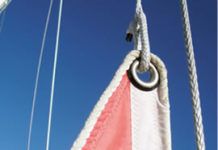Testing a Dynamic Traveler
Sailors gaze longingly at the rope wall at the local chandlery, coveting rope made from exotic fibers that promises ultra-low stretch and light weight, perfect for every halyard, sheet, and running-rigging application. But are they really? Certainly, there must be applications where a little stretch is a good thing, perhaps the best thing.
Untangling Furling-line Fairlead Logistics
Headsail furling on sailboats 40 feet and shorter should be able to be accomplished with a hand-over-hand pull on the furling line. If a large genoa is set and the breeze fills in abruptly, it may take a little coaxing with a winch to get things going, but when its a fairly light-wind day and you need to start cranking away on a primary winch to instigate the furl, something is wrong with the system.
Going Soft on Shackles
Fiber shackles have been in use for centuries-the simple knotted toggles provided all manner of service on square-riggers and even older craft. When made correctly with the right material, fiber shackles are strong, can be released without tools, and are jam-proof in the most severe weather. Like cotton sails, this 200-year-old technology has been updated through the use of modern materials.
UV, Chafe Protection
Last fall, we reported on how to build strong, hand-stitched eyes in the ends of a rope, a skill particularly useful for older halyards and sheets that are too stiff for a typical bury splice (see PS October 2014 online). We also warned against the ravages of ultraviolet rays (UV) and chafe on the stitching, since so much of the strength lies vulnerable on the surface. In this report, we look at means of protecting stitched splices from UV and chafe.
Abrasion and Break Testing
Testers first task was to determine whether any of these coatings could weaken line in the near term. To do this, we formed 20-inch loops of 1/8-inch polyester braid and nylon braid, coated a 1-inch length of the loop with each of the products, and broke these in our test rig.
Survey: Mainsail Track Hardware
Its been almost 10 years since Practical Sailor weighed in specifically on mainsail track hardware. (See Practical Sailor, Feb. 1, 2005 online) At the time, we offered a summary of the products designed to manage what we termed the three Ss of mainsail handling-setting, shortening, and striking. In that article, we focused on the gear used with full-battened mainsails, which were becoming increasingly popular among a broad spectrum of sailboat owners then.
Top Whipping Twines
The term whipping twine is somewhat misleading, suggesting a single purpose for a product with seemingly endless uses. These are the thin-woven strands that all hand-sewing projects depend upon, and in the process of exploring various stitching projects, weve gone through spools and spools of it.
Higher Loads Call for Careful Installation
Rope clutches are a great innovation that can help sailors better control the lines that lead aft to the cockpit and those that cluster around the mast base. But as with many good things, there is the risk of over-doing the benefit.
Break and Break Again
All lines were broken once to determine approximate breaking strength without a stitched eye. A simple chain fall and load cell provided a means of pulling test samples up to 5,000-pound loads. The samples were then sewn or knotted into dog bones 6 to 8 inches long with an eye on each end, and the load was again applied until failure. This allowed the testers to compare breaking strengths with and without a stitched eye or knot. The test was broken into two parts, laboratory and field testing.
Other Stitching Techniques that Work Well
We principally looked at three means of seizing an eye without splicing-basting, round-stitching, and seizing-used alone and in combination. Round stitching is described in the accompanying main article. Here are some of the other stitching patterns we tested.


















































